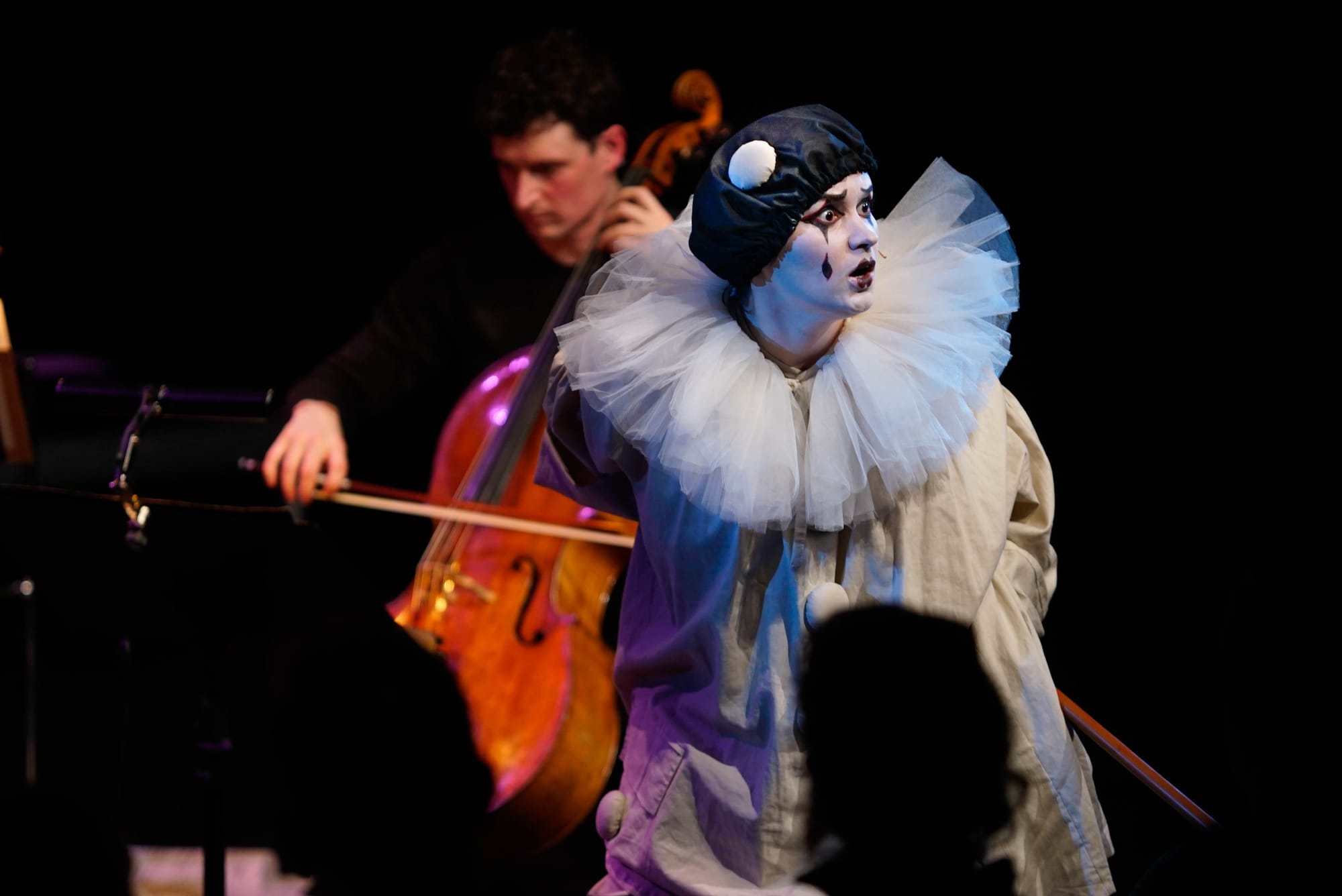PatKop's Poirot at the Southbank
Unforgettable

Patricia Kopatchinskaja & Friends: Pierrot Luniare. Patricia Kopatchinskaja (voice/violin); Meesun Hong Coleman (violin); Thomas Kaufmann (cello); Jülia Gállego (flute); Reto Nieri (clarinet); Joonas Ahonen (piano). Purcell Room, Southbank Centre, 03.12.2023
PatKop Flügelnwund for violin & 8 loudspeakers (electronic realisation, SWR Freiburg)
CPE Bach Presto in C minor, Wq114/3 (arr. PatKop)
Schoenberg Pierrot Lunaire, Op. 21, Part 1
Berio Song for clarinet
Violin Improvisation
Schoenberg Pierrot Lunaire, Op. 21, Part 2
PatKop Ghiribizzi (Whims) - excerpts
Milhaud Suite, Op. 157b: Jeu
Schoenberg Pierrot Lunaire, Op. 21, Part 3
If there is one piece that was always going to suit the force of Nature that is Patricia Kopatchinskaja to the ground, it is Schoenberg’s Pierrot Lunaire. She states, in an introductory note, that Pierrot has been ‘incarcerated in the prison of modernism, accessible only to the initiated’ and that it ‘has to be liberated’. Given the Commedia dell’arte origins of the central character, Kopatchinskaja’s clown-like attire (and face paint) seemed perfect. On entering, the stage was a (deliberate) mess, newspapers strewn randomly, a modernist canvas on an easel …
There was no formal artist entrance – PatKop was hiding at the back. The whole evening mirrored the sense of newness and discovery Schoenberg’s score must have breathed back in 1912. It is a place of maximal discombobulation, where consonance can appear as dissonance (or at least minus its characteristic directionality). Where inherited forms (passacaglia, canon) sit with the Sprechstimme – speech-song. Lighting was carefully considered (the stage drenched in purple/violet light for ‘Madonna,’ for example)
It has to be said, this performance made Kopatchinskaja’s Alpha recording sound tame. Perhaps it was the mobile element – this Pierrot’s world is the stage, and (s)he can interact with performers, sharing a stool, or stroking another performer affectionately. That recording has intriguing couplings of Schoenberg, Webern, J. Strauss II and Kreisler’s Little Viennese March. But here, it seemed even more logical. PatKoop’s own Flügelnwund for violin and eight speakers was an appropriately surreal experience. It did sound something like Stockhausen, perhaps (and gave this audience member a warm glow of nostalgia for it!). Spatial effects were carefully done and effective. It was similarly effective to insert ‘extra’ pieces between parts – readers might remember the Milhaud from PaKop’s last SouthBank appearance, in September this year.She took the CPE Bach and, in injecting pizzicato as part of the equation, lightened the music in duet with Reto Bieri’s expert clarinet.
Kopatchinskaja’s Pierrot is fragile. Projected translations at the back of the hall helped us understand the character’s extraordinary, zig-zag journey. Her voice is not the strongest but has an extraordinary variety, from scream to screech to squeal ‘(Der Dandy’; “Enhauptung’), from whimsy (‘Colombine’) to charming (‘Valse de Chopin’).
Berio’s Song for clarinet is of maximal eloquence, and there is surely no finer interpreter today than Bieri, who holds the key to the most magical, nearly inaudible pianissimi that speak volumes. But how dark the contrast with the first song of the second part, ‘Nacht (Passacaglia)’ - the text speaks, unforgettably, of ‘giant, black butterflies,’ and the nightmarish vision was all there.
One has to credit Joonas Ahonen’s superb pianism in ‘Gebet am Pierrot,’ complemented by the way Kopatchinskaja almost deconstructed language with her variety of sound, occasionally threatening to shred the word in question. And as for ‘Raub’ (Theft), it was the closest Schoenberg ever (unknowingly) came to rap music- more so than on the recording, certainly. She positively threw herself into ‘Die Kreuze’ (Crosses), making herself into a human cross via arms flung out; and the sudden change with a superb entrance from flautist Júlia Gállego was absolutely beautiful, as was Gállego’s fuller solo later on.
We heard some of PatKop’s Ghiribizzi (Whims) in the previous concert, too; just a few minutes this time, to remind us of the fertility of her imagination, before the phenomenally virtuosic Milhaud. Interlude, linking passage, moment of fun … somehow it seemed integrated with the Schoenberg rather than disjunctive.
The third part began with the sweet violin of Meesung Hong Coleman in ‘Heimweh’ (Homesickness), complemented by the virtuosity of Thomas Kaufmann’s cello in the very next ‘Gemeinheit!’ (Practical Joke). This was cabaret through a fairground mirror, or perhaps through a kaleidoscope. Perhaps the purest example of pure musical virtuosity from all concerned – tutti virtuoso, perhaps – was ‘Der ‘Mondfleck’ (Moonfleck), frenzied, almost exploding out of its own parameters,
A shadow is cast over the last few songs, as the music ‘goes home’ (‘Heimfahrt’) before finally reminiscing about ‘fairytale times’ (Märchenzeit).
This was truly an extraordinary experience. Kopatchinskaja learned Pierrot when she was temporarily divorced from her violin because of tendonitis, and it is one of her greatest musical gifts to us. With her Music for the Planet: Les Adieux from Gstaad this year still casting its shadow (the performance was on August 5 and the sun shone still), it is all credit to Kopatchinskaja that she can equal that in effect. Unforgettable.
